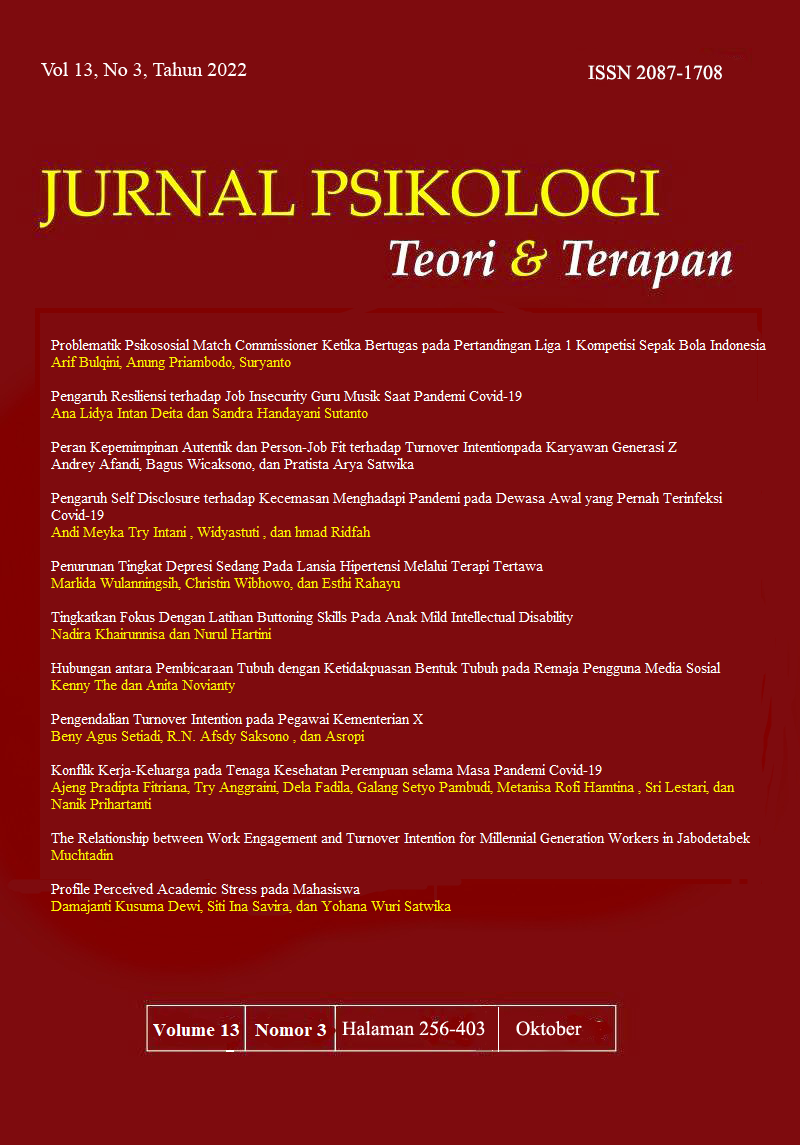Pengendalian Turnover Intention pada Pegawai Kementerian X
DOI:
https://doi.org/10.26740/jptt.v13n3.p351-364Keywords:
Job satisfaction , Career clarity , Promotion, Turnover intentionAbstract
This study aims to find the right controlling to control
turnover intention in employees at Ministry X. The
focus is emphasized on how the organization as a
career place provides opportunities for employees to
survive and advance the organization. This study uses a
qualitative approach with data obtained from Ministry
X participants purposely based on criteria that have
made a turnover, have a turnover intention, and are
staf managers. Data analysis is done by reducing,
presenting, and drawing conclusions. The results of this
study indicate that the turnover intention factor tends to
be determined by the encouragement of internal factors.
The internal factors that often arise are conveyed by
participants, namely job satisfaction related to
employee career clarity and employee promotion
opportunities. Controls that can be carried out are by
1) Implementing internal rules regarding job
information so that there is no gap between position
qualifications and current employee competencies; and
2) Making policies on employee career patterns and
implementing succession plans based on a merit system.
Contributions in this study contribute to the control of
turnover intention in government institutions.
Pergerakan organisasi ditentukan oleh adanya sumber daya manusia yang memiliki peran yang besar terhadap pencapaian kinerja organisasi secara keseluruhan sehingga sumber daya manusia dalam organisasi menjadi aset yang perlu untuk dipertahankan dan perlu pengelolaan jangka panjang. Penelitian ini dilakukan untuk mengetahui faktor turnover intention dan strategi pengendalian turnover intention di Kementerian X dengan metode penelitian kualitatif. Partisipan dalam penelitian ini adalah pegawai yang bekerja di kementerian X dan pegawai yang telah melakukan turnover di kementerian X. Hasil penelitian ini menunjukan bahwa faktor turnover intention cenderung ditentukan oleh faktor internal. Faktor internal yang muncul adalah kepuasan kerja yang berhubungan dengan kejelasan karier pegawai serta peluang promosi pegawai. Strategi pengendalian yang dapat dilakukan adalah dengan adanya Penerapan kebijakan dalam pengisian jabatan, peluang promosi dan kejelasan karier
References
Alemu, B. F., & Gezimu, S. G. (2018).
intention in government bureaus in
Ethiopian: The case of Dire Dawa
Administration. International Journal
of Scientific and Research
https://doi.org/10.29322/ijsrp.8.6.2018
.p7854
Annisa, W.P. & Frianto, A. (2019).
Pengaruh Pengembangan Karir
Terhadap Motivasi dan DAmpaknya
Terhadap Kinerja Karyawan (Studi
Kasus di PT. Barata Indonesia
(Persero) Gresik). Jurnal Ilmu
Manajemen (JIM). 7 (2).1-10.
Asropi. (2020). Sustainable development
in local government: A lesson from
Indonesia. International Journal of
Innovation, Creativity and Change,
De Cenzo, D.A. & Robbins, S.P. (2010).
Human Resources Management. New
Jersey: Wiley.
Dialoke, I., & Adighije, P. J. N. (2017).
Effects of Career Growth on
Employees Performance : A Study of
Non-Academic Staff of Michael
Okpara University of Agriculture
Umudike Abia State, Nigeria.
Singaporean Journal of Business
Economics and Management Studies,
https://doi.org/10.12816/0037246
Griffeth, R. W., Hom, P. W., & Gaertner, S.
(2000). A meta-analysis of antecedents
and correlates of employee turnover:
Update, moderator tests, and research implications for the next millennium.
Journal of Management, 26(3),
https://doi.org/10.1177/014920630002
Kadiman & Indriana, D. (2012). Pengaruh
Budaya Organisasi, Komitmen
Organsiasi dan Kepuasan Kerja
Terhadap Turnover Intention
Karyawan (Studi Kasus pada PT.
Nyonya Meneer Semarang). Juraksi, 1
(1), 57-72.
Luthans, Freed. (2006). Perilaku
Organisasi. Penerbit Andi Offset:
Jakarta.
Mello, J.A. (2011). Strategic Human
Resource Management. 3
rd Ed,
OH:Sout Western Cengage Learning.
Mobley, W.H. (1986). Pergantian
Karyawan: Sebab, Akibat dan
Pengendaliannya. Terjemahan. Jakarta
: Pustaka Binaman Pressindo
Mondy, W. R. (2010). Human Resource
Management 11
th Edition.
Pearson:London.
Novliadi, F. (2007). Ferry Novliadi :
Intensi Turnover Karyawan Ditinjau
Dari Budaya Perusahaan Dan
Kepuasan Kerja. Universitas Sumatera
Utara.
Nurmansyah, S. R. (2011). Manajemen
Sumber Daya Manusia Suatu
Pengantar. Penerbit Universitas
Lancang Kuning: Pekanbaru.
Park, S.H., Boyle, D.K.,
Bergguist-Beringer S., Staggs, V., &
Dunton, N.E. (2014). Concurent and
Lagged Effects of Registered Nurse
Turnover and Staffing on
Unit-Acquired Pressure Ulcers. Health
Services Research. 49 (4): 1205 -
https://doi.org/10.1111.1475-6773.121
Pitts, D., & Fernandez, S. (2001). So Hard
to Say Goodbye? Turnover Intention among U.S. Federal Employees.
Prasodjo, E., & Rudita, L. (2014).
Undang-Undang Aparatur Sipil
Negara : Membangun Profesionalisme
Aparatur Sipil Negara. Kebijakan Dan
Prawitasari, A. (2016). Faktor-faktor yang
Mempengerahui pada PT. Mandiri
Tunas Financce Bengkulu. Ekombis
Review: Jurnal Ilmiah Ekonomi dan
Rakhmawanto, A. (2020). Pengembangan
Karier Aparatur Sipil Negara Dalam
Perspektif Perencanaan Suksesi
Berbasis Merit System. Civil Service:
Jurnal Kebijakan Dan Manajemen
https://jurnal.bkn.go.id/index.php/asn/
article/view/242/201
Robbins, S.P. & Judge, T.A. (2008).
Perilaku Organisasi; edisi 12th
.
Salemba Empat: Jakarta.
Varshney, D. (2014). Impact of Self
Concept on Turnover Intention : an
Empirical Study Faculty of Economics
and Administration. American
International Journal of
Waldman, J.D., Kelly, F.K., Arora, S., &
Smith, H.L. (2004). The Shocking
Cost of Turnover in Health Care.
Health Care Management Review, 29
(1),2-7.
Wibisono, P. S. H. (2017). Bagaimana
Turnover Intention Generasi Millenial
Dan Non Millenial Dipengaruh
Meaning of Work Dan Job Satisfaction
(Studi Pada Bagian Administrasi Pts a,
Jakarta). Jurnal Manajemen, 14(2),
Downloads
Published
How to Cite
Issue
Section
License

This work is licensed under a Creative Commons Attribution-NonCommercial 4.0 International License.
Authors who publish in this journal agree to the following terms:
Copyright in any article is held by the author.
The author grants the journal, publication rights with the work simultaneously licensed under a Creative Commons Attribution License that allows others to share the work with an acknowledgment of the work's authorship and initial publication in this journal.
Authors may enter into separate, additional contractual arrangements for the non-exclusive distribution of the journal's published version of the work (e.g., posting it to an institutional repository or publishing it in a book), with an acknowledgment of its initial publication in this journal.
Authors are permitted and encouraged to post their work online (e.g., in an institutional repository or on their website) prior to and during the submission process, as this can lead to productive exchanges, as well as earlier and greater citation of published work.
 Abstract views: 876
,
Abstract views: 876
, PDF Downloads: 645
PDF Downloads: 645


















